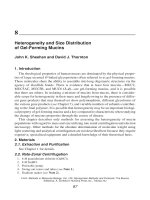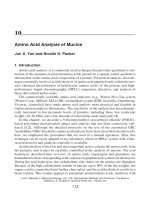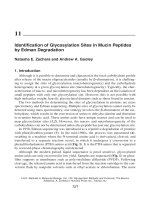Glycoprotein methods protocols - biotechnology 048-9-065-073.pdf
Bạn đang xem bản rút gọn của tài liệu. Xem và tải ngay bản đầy đủ của tài liệu tại đây (92.82 KB, 9 trang )
Biosynthesis and Secretion of Mucin 65
65
From:
Methods in Molecular Biology, Vol. 125: Glycoprotein Methods and Protocols: The Mucins
Edited by: A. Corfield © Humana Press Inc., Totowa, NJ
6
Quantitation of Biosynthesis
and Secretion of Mucin Using Metabolic Labeling
Jan Dekker, B. Jan-Willem Van Klinken,
Hans A. Büller, and Alexandra W. C. Einerhand
1. Introduction
Most epithelial mucins are secretory glycoproteins. The mucin-producing cells are
characterized by large intracellular stores of these very large and complex glycopro-
teins (1,2). These secretory mucins form mucous layers on the apical side of the cells,
protecting the vulnerable epithelium, while allowing selective interactions with the
apical environments, which is typically the lumen of an organ that is continuous with
the outer world. Secretion from mucin-producing cells is regulated. Normally, mucins
are constitutively secreted in relatively low amounts, which are sufficient under nor-
mal conditions to sustain the thickness of the mucous layer. On acute threats, the accu-
mulated mucins may be secreted in bulk amounts to provide mucus as an effective, yet
temporary, means of epithelial protection (1,2). Both types of secretion require syn-
thesis of mucin: constitutive secretion demands a continuous low level of biosynthesis,
whereas stimulated secretion requires massive synthesis to replenish the diminished
resources.
In particular pathological conditions, mucous production seems either to fall dra-
matically or to rise excessively, but systematic measurements of the actual changes in
mucin production at the various levels of regulation are most often not conducted. For
instance, in the chronic inflammatory bowel disease ulcerative colitis, it was debated
for many years whether mucous production actually dropped during the inflammation
(3). Only recently have researchers been able to show that MUC2 is the predominant
mucin in normal colon as well as in colon affected by ulcerative colitis, and that MUC2
production is actually decreased during active inflammation in ulcerative colitis (4–6).
Many researchers in the mucin field may therefore wish to quantify mucin synthe-
sis and secretion in health and disease, in order to determine the sequence and the
regulation of events. Only in this way will investigators be able fully to appreciate
mucin functions and hope to find ways to interfere in the production and secretion of
66 Dekker et al.
mucin. All secretory mucins display specific expression patterns in organs and cell
types, implying specific functions of each mucin. Logically, it is essential to be able to
measure mucin synthesis in a specific manner, i.e., to determine the level of gene-
specific expression of mucin. This can be done at the mucin mRNA level, as described
extensively in Chapter 25. However, the presence of mRNA is only indirect proof of
the biosynthesis of the encoded mucin. This point was proven by to our knowledge,
the only study that actually correlated the levels of mRNA, synthesis of mucin poly-
peptide, and mature mucin. This study, which formed the basis for this chapter, showed
that human colonic MUC2 mRNA, in normal individuals and in patients with ulcer-
ative colitis, did not correlate with MUC2 protein synthesis, but that the MUC2 pro-
tein synthesis correlated highly with the total amount of MUC2 present in the tissue
(6). Therefore, this study implies that MUC2 synthesis in the colon is primarily regu-
lated at the posttranscriptional level. Thus, researchers should be cautious to draw
conclusions about the amounts of mucins produced by cells or tissues, based on muci-
nous mRNA levels alone.
Quantitation of production of mucin through metabolic labeling by [
35
S]amino acids
at the polypeptide level has the advantage that it is a vital parameter: it is a measure of
the actual capability of cells or tissue to produce mucins (1,4–11). More important, a
distinction can be made with the preexisting, stored mucin in the mucin-producing
cells. Metabolic labeling during short periods (up to 60 min) will not add significant
mucin to the vast reservoir of stored mucins. Therefore, researchers will be able to
distinguish within one experiment the movements of two fundamentally different pools
of mucins: the preexisting, unlabeled bulk of the stored mucins; and a small but quite
recognizable amount of freshly synthesized mucin (1,6–8). An extra dimension can be
added by labeling mucins at the last step of their synthesis, through metabolic labeling
with [
35
S]sulfate. Thus, another defined pool of mucin molecules can be distinguished
and studied—the just synthesized but not yet stored mature mucin (1,7,8). A mucin
precursor is defined as a mucin polypeptide, present in the rough endoplasmic reticu-
lum, containing N-glycosylation but no O-glycosylation (which occurs only after arri-
val in the Golgi apparatus) (1,8). Mature mucins are defined as the end product of the
biosynthetic processes.
To ensure meaningful measurement of the biosynthesis of mucin, one must be able
to identify unequivocally the mucin precursor of interest. In practice this is done by
immunochemical techniques. However, immunoprecipitation of metabolically labeled
mucins is seldom quantitative, owing to the large amount of stored yet unlabeled mucin
that competes with the labeled mucin for the antibody (see also Chapter 20). Fortu-
nately, it appears that the most prevalent mucin precursors in any particular organ or
cell line can be distinguished in the homogenates of the tissue or cells in which they are
produced, by virtue of two general properties: mucin precursors are (1) extremely large
and (2) quite abundant in the tissues of cell lines in which they are produced. Each
precursor of the MUC-type mucins appears to display a unique molecular mass on
sodium dodecyl sulfate-polyacrylamide gel electrophoresis (SDS-PAGE), and once iden-
tified in the homogenates, mucin precursors can be quantified from SDS-PAGE analysis
(see Chapters 20 and 21 for the identification of the individual mucin precursors).
Biosynthesis and Secretion of Mucin 67
2. Materials
1. Bicinchoninic acid (BCA) kit to assay protein concentration (Pierce, Rockford, IL).
2. Bovine serum albumin (BSA) solution in homogenization buffer to provide calibration
for the protein assay.
3. 5% (w/v) trichloroacetic acid (TCA).
4. 3% stacking/4% running gels for SDS-PAGE, electrophoresis apparatus (mini Protean II
system; Bio-Rad, Richmond CA), and Laemmli electrophoresis buffers.
5. PhosphorImager (Molecular Dynamics, Sunnyvale, CA), with ImageQuant software (or equiv-
alent apparatus) to quantify the amount of radioactivity in an identified band on SDS-PAGE.
6. Poly- or monoclonal antibodies (IgG-type) against nonglycosylated regions of the mucin-
polypeptide of interest (see Chapter 20 for specific antibodies to recognize the major
MUC-type mucins).
7.
125
I-labeled protein A, specific activity 30 mCi/mg, supplied as solution of 100 µCi/mL
(1.1 GBq/mg; 3700 kBq/mL) (Amersham, Little Chalfont, Buckinghamshire, UK).
8. Dot-blot apparatus, vacuum operated (e.g., Bio-Dot, Bio-Rad).
9. Trizol RNA isolation solution (Gibco/BRL, Gaithersburg, MD).
10. Agarose gel electrophoresis apparatus, and 0.8% (w/v) agarose gels.
11. Radiolabeled, homologous cDNA or cRNA probe to quantify the mucin mRNA of inter-
est (see Chapters 24 to 27).
12. Radiolabeled, homologous cDNA or cRNA probe to quantify an appropriate control
mRNA in each cell sample, i.e., β-actin or glyceraldehydephosphate dehydrogenase.
13. Carbogen-gas container (95% O
2
/5% CO
2
) and pressure-reduction valve.
14. Tissue homogenizer (Glass/Teflon, Potter/Elvehjem homogenizer).
15. Sterile media for metabolic labeling: Eagle’s minimal essential medium (EMEM),
described in detail in Chapter 19 Subheading 2.
a. EMEM without methionine and cysteine.
b. EMEM without sulfate.
c. Standard EMEM.
16. Radiolabeled compounds (Amersham), described in detail in Chapter 19, Subheading 2.
a. Pro-Mix
TM
, containing a mixture of [
35
S]methionine/[
35
S]cysteine.
b. [
35
S]sulfate.
17. Water bath, 37°C.
18. Whatman 3MM filter paper.
19. Molecular weight marker: nonreduced monomeric and dimeric rat gastric mucin precur-
sors, molecular mass 300 and 600 kDa, respectively (8) (see Chapters 20 and 21).
20. Homogenization buffer (pH 7.5, 0°C): 50 mM Tris-HCl, 5 mM EDTA, 1% Triton X-100
(BDH, Poole, UK), 10 mM iodacetamide, 100 µg/mL soybean trypsin inhibitor, 10 µg/mL
pepstatin A, aprotinin 1% (v/v) form commercial solution, 1 mM phenylmethyl-
sulfonylfluoride (PMSF), 10 µg/mL leupeptin. All chemicals are from Sigma. PMSF is
unstable in water; add just before use, from 100 mM stock solution in 2-propanol.
21. Blotto (wash buffer for Western-type dot-blots): 50 mM Tris (pH 7.8), 2 mM CaCl
2
,
0.05% (v/v) Nonidet P-40 (BDH), 0.01% antifoam A (Sigma), 5% (w/v) nonfat milk
powder (Nutricia, Zoetermeer, The Netherlands).
22. Nitrocellulose paper (Nitran, Schleicher and Schuell, Dassell, Germany).
23. Saran Wrap (Dow Chemicals, Karlsruhe, Germany).
24. Scintillation counter, scintillation vials, and scintillation fluid (Ultima Gold, Packard,
Meriden, CT).
25. 50% ethanol/50% diethyl ether (v/v).
68 Dekker et al.
3. Methods
3.1. General Assays for Quantitation of Mucin (
see
Notes 1–3)
Each of these six detailed assays are used to quantify a particular aspect of the
biosynthesis of mucin. These assays are essential in the extensive protocol for quan-
titation of the biosynthesis and secretion of mucin, which is discussed in Subheadings
3.2. and 3.3.
1. Measure protein concentrations according to the BCA protein assay and calculate the
protein concentration of each homogenate, with the help of the BSA calibration solutions,
in micrograms/milliliter.
2. Measure the incorporation of radiolabel into (glyco-)proteins by TCA precipitation. Spot
5 µL of the homogenate on a pencil-marked location on 3MM Whatman filter paper and
air-dry. Immerse the filter paper in ice-cold 5% TCA for at least 10 min. Transfer paper to
5% TCA at 100°C for 10 min. Wash the paper two times for 5 min each in 5% TCA at
room temperature. Rinse once in 50% ethanol/50% diethyl ether and air-dry. Quantify the
amount of radiolabel incorporated in glycoproteins in the homogenate by liquid scintilla-
tion counting as counts per minute/milliliter of homogenate.
3. Identify and quantify the mucin precursor band in the homogenate after separation on
reducing 4% SDS-PAGE using the PhosphorImager (see Chapters 20 and 21). Calculate
the amount of mucin precursor as arbitrary units (au)/milliliter of homogenate.
4. Identify and quantify the mature mucin band in the homogenate and medium after
separation on reducing 4% SDS-PAGE using the PhosphorImager (see Note 4). Cal-
culate the amount of mature mucin as au/milliliter of homogenate or as au/milliliter
of medium.
5. Quantify the total amount of the mucin of interest in the homogenate and medium by
Western-type dot-blot procedure. Spot aliquots of the homogenates or media on nitrocel-
lulose paper, using the dot-blot apparatus and air-dry for 5 min. Perform all ensuing pro-
cedures in Blotto as follows:
a. Incubate in Blotto for 30 min, and incubate with antibody directed against nongly-
cosylated peptide epitopes of the mucin of interest for 90 min.
b. Wash two times for 15 min each.
c. Incubate with 0.5 µCi of (185 kBq)
125
I-labeled protein A for 60 min.
d. Wash twice for 5 min each in Blotto, and then wash once for 5 min in phosphate-
buffered saline.
e. Dry filter briefly using Whatman 3MM paper, and cover the filter in Saran Wrap.
f. Place two sheets of Whatman 3MM paper between the filter and the PhosphorImager
screen to exclude the
35
S radiation, owing to the endogenous radiolabeled compounds
in the homogenate, from reaching the screen.
g. Quantify the
125
I label per dot using the PhosphorImager as au/milliliter of homoge-
nate or au/milliliter of medium (see Note 5).
6. Isolate RNA by the Trizol method, and quantify RNA at A
260nm
/milliliter. Judge the intact-
ness of the RNA, by analysis of the 18S and 28S rRNA bands on 0.8% agarose electro-
phoresis. The mucin mRNA of interest is quantified, using a specific homologous cDNA
or an antisense cRNA probe, by dot-blotting, using the dot-blot apparatus. The specific
signal is quantified using the PhosphorImager as au/A
260nm
.
Biosynthesis and Secretion of Mucin 69
3.2. Quantitation of Biosynthesis
of Mucin (
see
Notes 4 and 6–9).
Four mucin-producing cell samples are used: they can be biopsies, tissue explants,
or cell line cultures. Metabolic pulse/chase labeling of biopsies and tissue explants is
conducted individually submerged in the appropriate medium in small tubes, as
described in Chapters 18 and 19.
3.2.1. Cell or Tissue Sample No. 1:
Quantitation of Mucin Precursor Synthesis
1. Cell or tissue sample no. 1 is pulse labeled with [
35
S]methionine/cysteine for 15–60 min,
as described in Chapter 19. Homogenize the sample in homogenization buffer on ice,
isolate the supernatant by 5 min centrifugation at 12,000g, and measure the following
parameters:
a. Protein concentration (mg/mL).
b. Protein synthesis, i.e., [
35
S]amino acids–labeled, TCA-precipitable proteins (cpm/mL).
c. [
35
S]Amino acids–labeled mucin precursor-band on 4% SDS-PAGE (au/mL).
d. Total concentration of mucin by dot-blotting (au/mL).
3.2.2. Cell or Tissue Sample No. 2:
Quantitation of Synthesis of Mature Mucin
1. Cell or tissue sample no. 2 is pulse labeled with [
35
S]sulfate for 30–60 min, as described
in Chapter 19. Homogenize the cell sample in homogenization buffer on ice, isolate the
supernatant by 5 min centrifugation at 12,000g, and measure the following components:
e. Protein concentration (mg/mL).
f. Sulfate incorporation as [
35
S]sulfate-labeled, TCA-precipitable proteins (cpm/mL)
(see Note 10).
g. Mature [
35
S]sulfate-labeled, mucin band on 4% SDS-PAGE (au/mL).
h. Total concentration of mucin by dot-blotting (au/mL).
3.2.3. Cell or Tissue Sample No. 3:
Quantitation of Secretion of Mature Mucin
1. Cell or tissue sample no. 3 is pulse labeled with [
35
S]sulfate, and then chase incubated in
the absence of radioactive sulfate for 4–6 h. Isolate medium from the chase incubation,
homogenize tissue in homogenization buffer, and isolate the supernatant by 5 min cen-
trifugation at 12,000g. Mix the medium with an equal amount of homogenization buffer.
Measure the following components:
i. Protein concentration of tissue homogenate (mg/mL).
j. Total sulfate incorporation as [
35
S]sulfate-labeled, TCA-precipitable proteins in tis-
sue homogenate (j1) and medium (j2) (cpm/mL) (Note 10).
k. Mature [
35
S]sulfate-labeled mucin band in tissue homogenate (k1) and medium (k2)
on 4% SDS-PAGE (au/mL).
m. Total concentration of mucin in tissue homogenate (m1) and medium (m2) by dot-
blotting (au/mL).
3.2.4. Cell or Tissue Sample No. 4: Quantitation of Mucin mRNA
1. Cell or tissue sample no. 4 is homogenized in Trizol solution, and the RNA is isolated
according to the manufacturer. Measure the following components:









